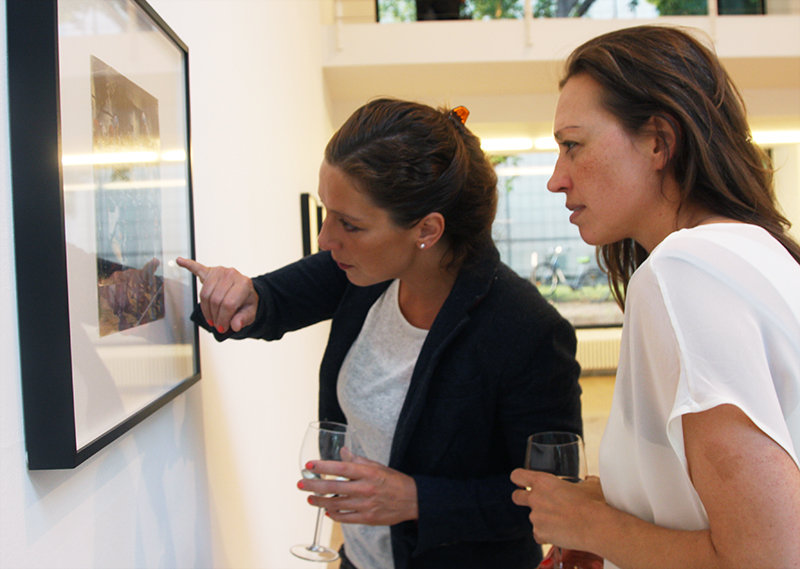empathy
What Do We Look For In Art?

John Stezaker is an image collector; an English conceptual artist who works with photomontage. He does not take the photos but finds them, puts them into a new context and creates a thought-striking composition made of two different images. In 2012 he won the Deutsche Börse Photography Prize—a controversial election due to the fact that he did not in actuality take any photos. However, the fact that these combinations create new narratives and possess poetic resonance grants them autonomy and self-sufficiency as art works. He is currently exhibiting his show, "Crossing Over," at Capitain Petzel, where the pristine white atmosphere is magically interrupted by sunlight and trees.
GALLERIES: CROSS OVER TO THIS SIDE OF THE BUZZ! JOIN THE SWARM TODAY!
These photo collages are not cut out and assembled pieces of photos, they are two juxtaposed images. It is explicit that there is something hidden in order to give birth to a revealing new visual. The artist is strongly influenced by Surrealism: he admires Giorgio de Chirico and Giovanni Piranesi. In interviews, he has mentioned that he likes to find the 'point in the middle,' where one image crosses over another one to create a third visual.
A useful comparison to fully grasp this idea is to think about translation: the point in the middle between two languages when it is not so clear how to configure the same idea in new terms. That space in between is what makes these images surreal. They could be visuals from a dreamed world or symbols of our longings, fears, anxieties and fantasies.
At the opening, not only photomontages where exhibited, there were also two videos in the basement room. They were ‘motion collages.’ One video was made from various photos of different horses that were so rapidly displayed that the viewer perceived the images in assemblage. Many old fans were not aware of his work with this media – they were definitely the surprise of the show. Naturally, it is a more aggressive approach when it comes to immediate perception, looking at the video for a long time was both exhausting and made viewers dizzy.
Collecting Impressions
We met several Stezaker enthusiasts. Anastasia Vasilakis, for example, already knew and followed the artist for a long time. She mentions liking his work because it “reminds you about the absence of things.” She was making reference to the landscape series on the first floor. Two different and bare landscapes were juxtaposed and gave the feeling of echoing into eternity. They were truly evocative because the movement that was implied from one image to the next gave the feeling of one world crossing over to another.
Two Stezaker fans were discussing a collage featuring one photo of an injured or dying Indian surrounded by other men, on top of it a photo depicting a battle was placed. Tina Muller, another visitor, referred to the fact that, "They all look the same at first glance, because they are all wearing turbans. However, if you take a second, closer look, you realize that their turbans are radically different." She continues, "You have to look at it twice. In fact, the whole exhibition is better and complete the second time you go through it. It’s about details. I love his work because it’s always a surprise. I like it when art amuses me."
While taking a closer look myself, I realized that the photo on top is covering the agonizing scene of one man dying. The verb agonize comes from Classical Greek 'agon,' meaning to battle; to struggle (athletically or in the soul). It makes perfect sense that the artist chose a photo of a fight symbolizing the tension that goes on in the moment of dying or letting go.
Alexandra Gee, another all-time fan of the artist, made mention to the very tiny photos located on the first floor of the exhibition. They were not collages, but small pieces of photos surrounded by a lot of empty space. “I really like them because they give you the sense that you have to dig really deep into them in order to understand," she said, "It is like a window inviting you to go through it in order to discover something else. Even though the photo is small, you can feel it is somehow relevant".
However, not all impressions were positive. We talked to Ida Koitila and Nancy Gorlach, who didn't know the artist before going to the opening. Ida shares with us: "Nothing is really super close to my heart. I don’t particularly like the temperament of the art. I feel like art is about choosing something about the whole world to represent and I just don’t feel related to what he chose to represent about the world.” Although, she agrees that sometimes it takes time to get to know an artist and to ‘make friends’ with the art work. Her friend, Nancy, concurs and adds: “I think art has to remind you a bit about yourself, to have some sort of connection to who you are, what you like, what you fear. For me, it’s a little too abstract.”
Whether impressions are negative or positive, going to an opening is always an enlightening experience. Art is an endless source of debate about ourselves, the world, current events, our fortunes and misfortunes. The moment when people are willing to perceive something new, and share it, is golden. You know, the same thing Hemingway said about Paris could be said about art: it's always worth it, and you receive return for whatever you bring into it.
Capitain Petzel – "Crossing Over" by John Stezaker – June 27th to August 31st, 2013 – [Prince range of works: 8,000 to 27,000 British Pounds (9,300 to 31,500 Euros)]
Article by Sofía Martinelli
Be the first to write a comment.
Your feedback




